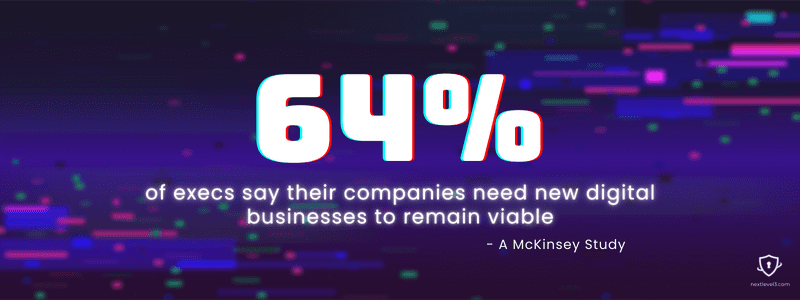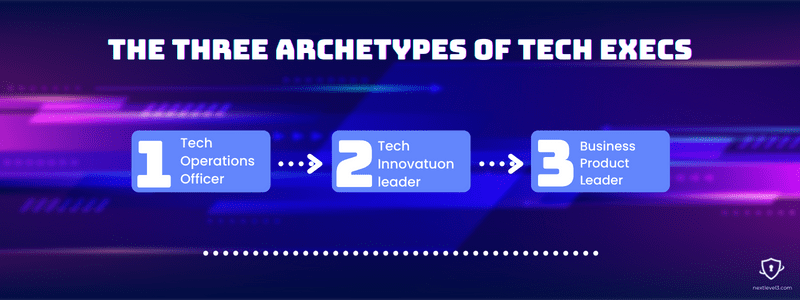CTO and CIO roles are changing. How does this impact your decision-making and support for new security tech?
For many business executives, digital transformation is becoming increasingly urgent, and they’re relying heavily on a new breed of CIOs and CTOs to modernize and lead the charge. A McKinsey study showed that 64% of execs say their companies need new digital businesses to remain viable — that’s where you come in.

Tech executive roles must have a seat at the leadership table, but they’re also relatively new and still evolving – especially CIO and CISO roles. Plus, with tech moving so quickly and businesses feeling pressure to pivot or evolve, aligning your organization’s objectives with an ever-changing landscape requires a broad skill set and clear priorities.
Some of the questions you’re likely asking as you shape your new strategy are:
- How do the different needs of the organization impact my priorities as a new CTO or CIO?
- How can I juggle competing incentives?
- What are the most effective ways to advocate for needed tech solutions for my departments?
Let’s examine the three strategic focus areas for most CTOs and CIOs and how understanding them can shine a light on ways you may need to evolve your role.
The current industry understanding of CIO and CTOs roles
If your role is new to the org altogether, you may be walking into a situation where there’s a lack of clarity on the distinction between CIO and CTO positions and where their scope of influence lies. While they’re both IT-related, Chief Information Officer and Chief Technology Officer have distinct areas of responsibility.
CIO is internal facing
The CIO is responsible for internal systems and operations related to IT. They manage:
Security
Internal IT policies
Tech infrastructure
IT operations
Vendor relationships for internal tech stack
Employee training
Ultimately, they’re working to improve the efficiency of systems and operations for the company. They also research and implement new processes and technologies for internal use. This can be a big job since surveys show that 50% of office workers say outdated tech affects their productivity.
CTO is external facing
The CTO is responsible for customer-facing technology, often for products offered by the company, ensuring they have the best solutions for end users. They manage:
Tech product development
Engineer teams
Improving user experience
Revenue goals and initiatives
Vendor relationships for tech products
Prospective product tech solutions
They spend time understanding tech trends, what other companies are doing, what customers need, and what solutions the company should adopt. Vishal Gupta, senior VP at Lexmar, says CTOs collaborate with “Four key stakeholders: marketing and sales, customers and partners, technology teams, and the
Tech execs stand at the intersection of business, technology, and operations
While there are distinct differences between CTOs and CIOs, there are also some overlaps in their focus and how they go about decision making. As with all C-level execs, there are no hard lines in what defines a role. Decisions are made by identifying the driving incentives and assessing available information, and – depending on the maturing of your organization – you may find that the focus area is blurry until you align expectations with your c-suite.
There are three focus areas or archetypes for tech execs. Depending on company needs, your role may embody a certain archetype more than the others. Understanding which lens will most effectively position you to reach your objectives can help organize motivations in strategic decisions.

Here are the three main focus areas that could shape your role definition – or signal a shift is needed.
Tech Operations Officer
The Tech Operations Officer archetype makes sure IT departments and data centers run smoothly. They work to improve existing systems and procedures, reviewing solutions and streamlining efficiency. This lens focuses heavily on day-to-day department procedures and improving processes and tools, as a large part of the CTO or CIO role will likely include operationalization for your department.
Tech Innovation Leader
The Tech Innovation Leader continuously focuses on current on tech innovations. They strategize and advise on new solutions, keeping the organization competitive with emerging industry trends. This lens takes a macro view of the company’s tech within the larger landscape. Fulfilling a Tech Innovation Leader archetype is significantly more transformational, and you may have some friction as you seek to evolve your new role as CTO or CIO to champion emerging tech.
Business Product Leader
The Business Product Leader archetype aligns the company’s products with its business strategy and works to improve customer satisfaction. They drive revenue, improve products and services, and manage development teams. This lens is focused on how tech is optimized for the business and its products. Like the “Tech Operations Officer” archetype, this is likely a large part of the early functional expectations of the CTO or CIO role you will be fulfilling.
How your focus changes decision-making and strategic impact
These three archetypes can easily bleed into each other. Any CIO or CTO role will likely have decisions to make using each lens at different times. It may also be likely that your responsibilities require you to view goals through one lens more often than the others. Here are some ways priorities can change, depending on your strategic focus.
Tech operations officer | Tech innovation leader | Business product leader | |
| Understand new tech trends | Low priority | High priority | High priority |
| Streamline existing tech stack | High priority | Medium priority | Low priority |
| Implement new concepts and tools | Medium priority | High priority | High priority |
| Deep understanding of security | High priority | Low priority | Medium priority |
| React to ongoing issues and problems | High priority | Medium priority | High priority |
Intentionally drive the evolution of your tech exec role to meet company needs
Every CIO and CTO has a wide scope of responsibility, and the three lenses can often become blurred, making it difficult to prioritize factors for decision-making.
Doing everything can sometimes mean doing nothing. And advocating for the best tech solutions for the company requires a clear vision. It’s essential to define the focus areas that your company needs and become an expert. Understand which lens you need and how it affects how you advocate for solutions.
Tech isn’t static. If you’re stuck working as a tech executive that’s inherited ineffective organizational strategies that won’t meet your objectives, find a way to refocus and view problems through the right lens.
